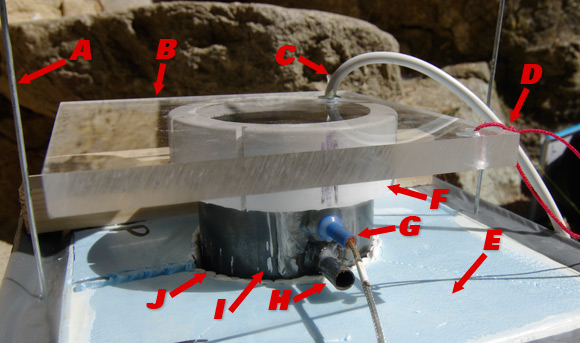This article is more than 1 year old
LOHAN finally checks into REHAB
First hypobaric rocket motor test today
We're pleased to announce that today sees the first of our Rocketry Experimental High Altitude Barosimulator (REHAB) experiments, meaning we'll finally find out if solid rocket motors will fire under simulated high-altitude conditions.
 After months of head-scratching, faffing and garden shed jiggery-pokery, the Low Orbit Helium Assisted Navigator (LOHAN) hypobaric rig is good to go.
After months of head-scratching, faffing and garden shed jiggery-pokery, the Low Orbit Helium Assisted Navigator (LOHAN) hypobaric rig is good to go.
To recap, the REHAB test is a vital part of our audacious spaceplane mission, since the Vulture 2 aircraft will be carried aloft under a helium-filled meteorological balloon and then required to thunder heavenwards propelled by a solid fuel powerplant.
Obviously, if the motor won't fire at -60°C and 15mmHg, we've got a problem with that cunning plan.
So, we'd rather know well in advance if the rocket motor will work. Following plenty of invaluable reader input, we put together this final concept graphic of the REHAB chamber...
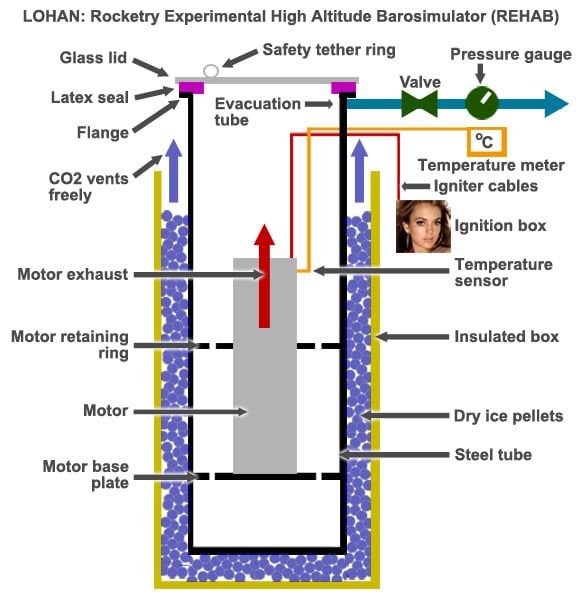
...which ultimately translated into this real-world rig:
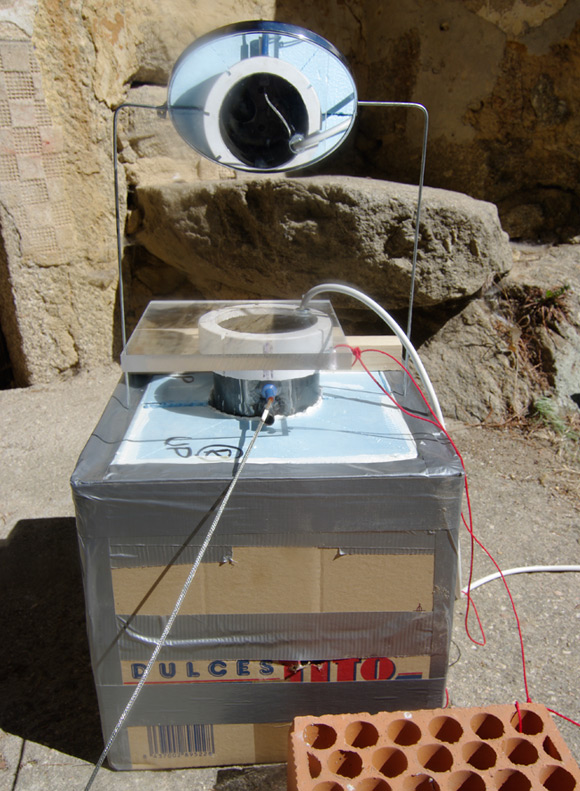
In case you're wondering just what on God's Green Earth is going on here, please have a shufti at this, this and this for enlightenment.
In the above snap you can see the REHAB chamber sitting in its insulated box - a quality piece of bodging involving a cardboard box, 30mm rigid insulation and the obligatory gaffer tape.
The bit of wood you can just see at the back is the handle which allows us to remove half of the lid to fill the box with dry ice. We won't need to do this for the first test, but LOHAN's impressive box is good to go.
Above the box is our beautifully engineered monitoring mirror swivel assembly, which allows us to film the inside of the chamber without risking our expensive video camera.
And of course, the chamber's perspex lid is safety tethered to the now traditional SPB Standard Brick (SPBSB), for the benefit of my mate Eloy, who has previously protested our inability to source a more interesting block of fired clay for readers' viewing pleasure.
Here's a detail shot of the top of the REHAB chamber, which you can click for a big version in a new window:
The details are as follows:
- Mirror support arm.
- Perspex lid.
- Igniter connection cable.
- Safety tether line.
- Insulated box.
- Silicone seal.
- Thermocouple cable feedthrough.
- Vacuum outlet.
- REHAB chamber.
- Foam seal.
Just to clarify, the igniter connection cable was going to pass through the wall of the REHAB chamber, but we reckoned it'd be easier if it went through the lid. It's epoxied into place, as is the thermocouple cable, which also has the benefit of some gasket sealant to ensure an airtight seal.
That's the REHAB chamber ready to roll, so let's have a look at the vacuum pump bit of the experiment.
Those of you who've been following LOHAN over these part months will know that just how to get LOHAN to suck satisfactorily has been an uphill struggle.
We started out trying fridge compressors, and after they clapped out, blew some wad on a proper vacuum pump, and after a right plumbing palaver, ended up with this set-up:
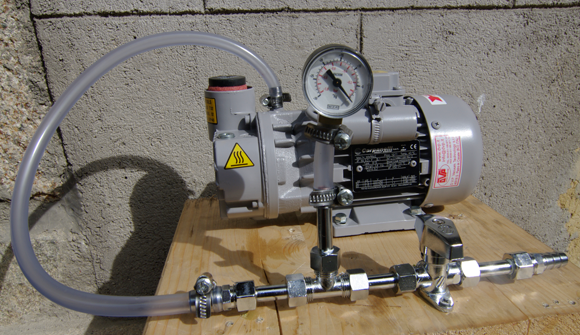
In tests, we were able to draw an indicated vacuum of 27.5 inches – equivalent to a pressure of 60mmHg, or an altitude of 60,000ft (18,290m).
There were concerns that the vacuum gauge might not be reading correctly, or that the SPB's mountaintop test facility - situated at 1,100m (3,600ft) above sea level - may affect the maximum possible indicated vacuum.
At this point, the firm which supplied the vacuum pump - Applied Vacuum Engineering (AVE) - stepped in sort the problem once and for all.
AVE head honcho John Licence got in touch to offer us the loan of a shiny and expensive suppressed zero gauge, designed to kick in below 50mbar and with an accuracy of around 1mbar.
While he was at it, he put us out of our plumbing misery and sent over a proper manifold. We're sure readers will join us in raising a pint to John and his team for their invaluable advice and support, which enabled us to assemble this impressive piece of DIY hypobaric gadgetry:
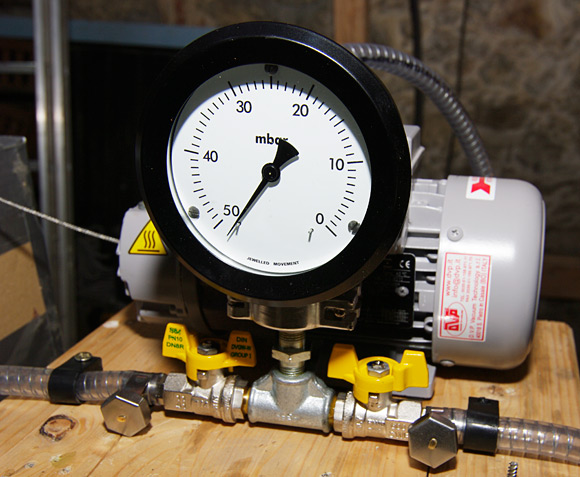
With the pump fired up and connected to the REHAB chamber, we managed to draw a vacuum of 20mbar – equivalent to around 76,500ft, or 23,300m - pretty well spot on our target of 15mmHg.
It's possible there's some leakage around the chamber's silicone seal, so we'll try to address that on the ground today and see if we can't get LOHAN to suck just a little bit more.
What LOHAN will have to suck first is our principal test motor – the AeroTech RC 32/60-100NS – laid out below (clockwise from left) with its G-class reload, motor case, sealing ring, end cap and nozzle:
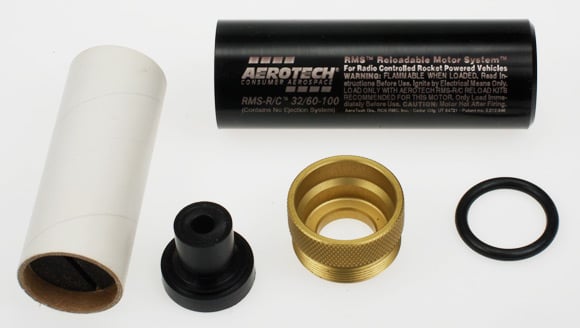
We do now have a second unit - a Cesaroni P29-1G casing, with a 57F59-12A "White Thunder" reload...
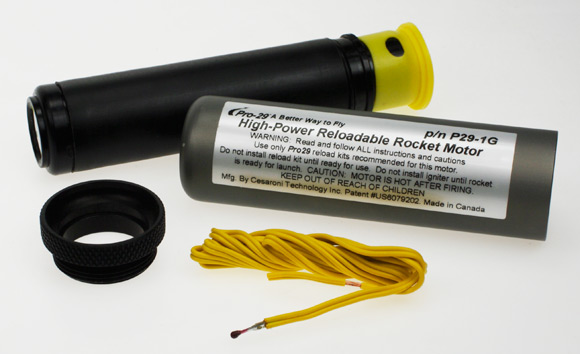
...but if the the AeroTech kit fires first time, we'll save the Cesaroni for later use.
Note that neither of the above is the motor we'll finally be using, but our reasoning is if we can get these two units to ignite, we're good to go with other (=bigger) models from the same manufacturers.
AeroTech president Gary Rosenfield told us last year he didn't know "if the motor will ignite reliably at that altitude without a burst plug or other means to retain internal pressure".
We shall see. Our plan is to test the motors first at low pressure, without dropping the temperature. If they won't play ball, we'll address that issue first and then get the dry ice in for the -60°C blast.
For today's first REHAB outing, we've managed to secure a rather impressive test location, which should add extra entertainment value to this particular piece of ballocket tomfoolery.
Keep watching the skies for news tomorrow on whether or not we blew up a historic Spanish building...®
Further LOHAN resources:
- New to LOHAN? Try this mission summary for enlightenment.
- You can find full LOHAN coverage right here.
- Join the expert LOHAN debate down at Reg forums.
- All the LOHAN and Paper Aircraft Released Into Space (PARIS) vids live on YouTube.
- For our SPB photo archive, proceed directly to Flickr.
- We sometimes indulge in light consensual tweeting, as you can see here.
